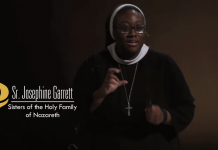
WILLIAM O’LEARY
Amidst the COVID-19 pandemic, our kids are now home all day and sometimes claim they “cannot do anything!”
As much as we enjoy our children, hearing this complaint throughout the day has already worn out its welcome. If this is their reaction after a week, how are we ever going to survive another 30 days (at least)?
As a parent, you, too, may have to work from home, or perhaps you are even without work right now.
Anxiety steals our peace
How are you adjusting to all this change? For so many, these changes mean adjustments on many levels. We are having to reorganize what feels like everything: our work schedule, our kids’ schedules (or non-schedules), our week planning, etc.
These changes can bring anxiety, and that is the thief of peace. How can we ward off anxiety and, in turn, bring order, peace, and routine into our homes?
Seek proper order – like the monks do
My wife, Sarah, claims that when we return to proper order, our behavior changes (or our children’s behavior changes.) Usually, when she calls for a return to order, our children groan — as it may mean more chores and less leisure.
Sarah often calls for a return to proper order when schedules have been disrupted. Chores may have been omitted, and arguing becomes the favored communication medium among the O’Leary kids. (I am sure that only happens in my home.)
Western monasticism paved the way for lives in proper order for centuries as they established a daily rule or proper order to their day. The primary example of this is found in the Benedictines, founded by St. Benedict.
Benedictine monks live by a motto that frames their life: prayer and work, or in Latin, Ora et Labora.
Their motto governs habits and gives shape to their day. Depending on the monastery, it may look something like:
4:50 am: Rise from bed
5:30 am: VIGILS — The first gathered prayer time with fellow monks
6:20 am: Breakfast
7:00 am: LAUDS — The second gathering of prayer with fellow monks
7:30 am: Lectio Divina — that basic monastic practice of reading (and praying with) the Scripture
9:00 am: TERCE and MASS — The third time of gathering with fellow monks for prayer and Mass
10:00 am: Each monk tends to the responsibilities they have inside or outside the monastery
1:00 pm: SEXT (sixth hour) — The fourth gathering of prayer of the day (very short)
1:15 pm: Lunch
1:45 pm: A time for rest and interacting with fellow monks
2:20 pm: NONE — The fifth communal prayer time in the church
2:30 pm: Back to work on daily responsibilities
4:30 pm: Monks gathering together for a brief time of community
5:00 pm: VESPERS — The sixth prayer gathering of the day
5:30 pm: A time to take care of various monastic affairs: meetings, research, spiritual direction, etc.
7:00 pm: Dinner
8:00 pm: COMPLINE — The seventh and final community prayer of the day. The monastic day ends
A return to proper order, especially during this time of “new normal” in family homes, will not look identical to the Benedictine order (although it would fill my children’s “argue time” with prayer — and that is appealing.)
Find YOUR family’s Rule of Life
It is worth considering having your family develop a rule of life/a specific schedule that will allow for a harmonious ebb and flow to this new way of life to which everyone is adjusting. Your family’s rule will look different from mine, as it is specific to your family.
Below is the O’Leary family “Rule of Life.” While we have yet to create a motto, feel free to borrow and adapt our schedule:
- 6:30 am: Wake up. We keep this time year-round. It helps to establish a time where everyone rises and gathers either for breakfast (even if informal) and maybe a brief prayer together to begin the day.
- 7:00 am: Kids set up for their schoolwork before my wife and I begin focusing on our daily work. Expectations for kids are clearly laid out as are the post schoolwork tasks.
- 10:00 am: Break (for snacks, answering questions, following up on any loose ends and focusing on the next two hours)
- Noon or 12:30 pm: Lunch (before lunch we read a Psalm together or pray a special prayer (the Memorare, Litany of St. Joseph, or the Angelus).
- 1:00 pm: Activity time. Kids need to release some wiggles!
- 1:30 pm: What other schoolwork do the kids need to complete? What are the chores waiting for them?
- A note about chores: Even if your kids don’t usually do chores, this is a good time to let them know that it is important that everyone pitches in at this present time. Sarah and I like to remind our children that we are all stewards of our space. Everyone has responsibilities in our home. Our kids know that the family is counting on them for the particular chores they have been given: setting the table, cleaning the floors in each room, wiping off doorknobs, folding laundry, putting dirty laundry in a designated place, etc.
- 5:00 pm: Preparation for Dinner
- 6:00 pm: Dinner
- 6:30 pm: Clean up (In our home, whoever cooks, the others clean up. My wife is our cook so she takes a break.)
- 7:00 pm: Family Rosary or brief time of prayer (maybe reading the Mass readings or praying the Stations of the Cross – you can find many options on Youtube )
- 7:30 pm or 8:00 pm: Kids shower and then quiet time (reading before bed)
- 8:00 pm or 8:30 pm: Family prayer before bed and lights out.
This daily rule may seem initially overwhelming especially if you do not maintain a daily schedule, however, I encourage you to try your own schedule or “rule of life.” My family has found that it gives us a sense of order, especially at a time that feels unstructured.
It’s amazing the peace a rule of life can bring for your family during these uncertain times.
Be committed
Don’t give up on day 2. It’ll take a number of days to get into the routine. Habits and routines aren’t formed in a day or two … or three.
William O’Leary lives in Kansas with his wife and three children. He is the Director of Religious Education for a large parish in Overland Park, Kansas. For more than 20 years, his work in pastoral ministry has explored ways to draw parents and their children into the practice of their faith. His blog is RelevantCatechesis.com.
Read more articles about catechesis at home during a crisis.
Image credit: Glenn Carstens-Peters on Unsplash




